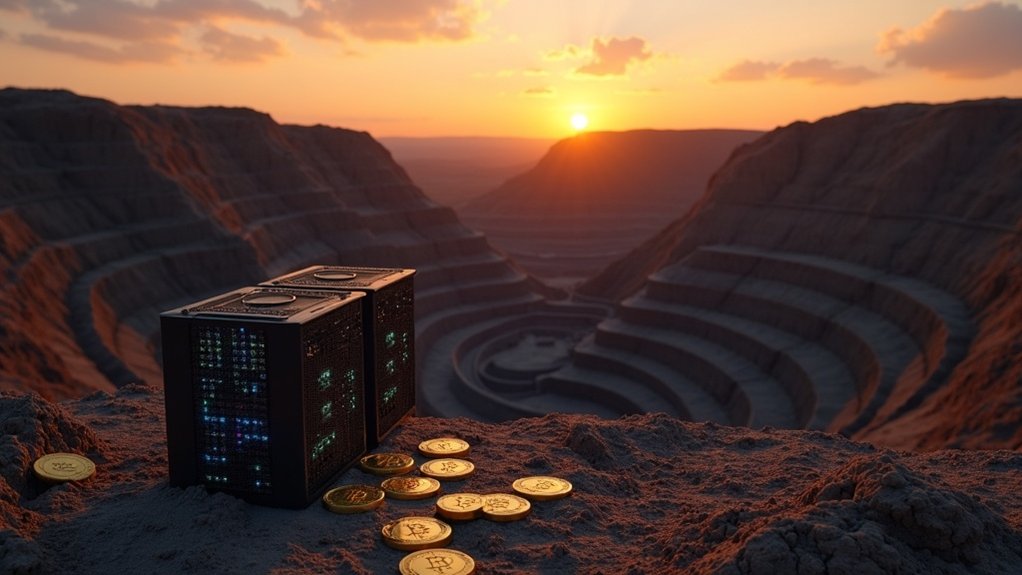When all 21 million bitcoins are mined around 2140, mining rewards vanish. Miners will survive solely on transaction fees. Network security depends on these fees becoming substantial enough to incentivize continued operations. Bitcoin’s deflationary nature intensifies as no new coins enter circulation. The wealthy hoard, the poor scramble. Mining operations consolidate among the most efficient players. Some lost coins (estimated 1.6 million) will never return to circulation. The economics after mining’s end reveal Bitcoin’s true staying power.
When will the last bitcoin be mined?
Not anytime soon.
The final bitcoin won’t enter circulation until approximately 2140—over a century from now.
Bitcoin’s protocol enforces a hard cap of 21 million coins, making it fundamentally different from the infinite money printer of fiat currencies.
Right now, about 20 million are already in circulation.
We’re getting close to the ceiling.
The remaining million will trickle into existence at an increasingly slower rate.
That’s the beauty—or frustration—of Bitcoin’s halving mechanism.
Market volatility typically increases during these halving events as supply becomes more restricted.
Every four years, the mining reward gets cut in half.
Fewer coins, more waiting.
The actual final supply might fall slightly under 21 million due to some mathematical quirks in the halving calculation.
Think 20,999,999.9769 BTC.
Close enough.
So what happens when the music stops?
Mining doesn’t end—it transforms.
Miners currently earn both newly minted bitcoins and transaction fees.
When new coins vanish from the equation, transaction fees become everything.
Users wanting their transactions processed will need to pay up.
Simple economics.
This creates fascinating security questions.
Will transaction fees alone provide enough incentive to maintain the network’s robust security?
Nobody knows for sure.
The mining landscape will likely consolidate as less efficient operations fold.
Survival of the fittest, crypto style.
Could Bitcoin’s supply cap ever change?
Technically yes, practically no.
Modifying this fundamental feature would require widespread consensus among miners, developers, and users.
Good luck with that.
The community guards Bitcoin’s scarcity like dragons protect gold.
Any attempt to inflate the supply would likely result in contentious hard forks and community warfare.
Nearly 1.6 million bitcoins are estimated to be permanently lost due to mismanaged custody, further reducing the effective supply.
Each unit of Bitcoin can be divided into 100 million satoshis for transactions, ensuring usability despite the limited supply.
For investors and economists, a truly fixed-supply asset is revolutionary.
Bitcoin becomes purely deflationary—a digital commodity that cannot be diluted.
Corporations and institutions are already stockpiling it as inflation insurance.
When the last satoshi enters circulation, Bitcoin will complete its transformation from experimental digital cash to the ultimate scarce asset.
No central bank required.
Frequently Asked Questions
Will Bitcoin Mining Still Be Profitable Without Block Rewards?
Mining profitability without block rewards? It’s complicated.
Miners will rely solely on transaction fees, which are wildly unpredictable.
Profitability depends on multiple factors: Bitcoin’s price, transaction volume, fee market dynamics, and operational costs.
Some miners will adapt and survive. Others won’t.
Large operations with cheap electricity and efficient hardware have the best shot. Small miners? Probably toast.
The network might see increased centralization as a result.
Nothing’s guaranteed in crypto, especially mining economics.
Can Bitcoin’s Total Supply Limit Be Changed Through Protocol Updates?
Technically, yes. Bitcoin’s 21 million supply cap could be changed through a protocol update. But good luck with that.
The change would require overwhelming consensus from miners, nodes, developers, and users worldwide. Not happening.
Bitcoin’s value proposition hinges on its scarcity.
Any attempt to increase supply would likely create a contentious fork, not true Bitcoin.
The community fiercely guards this monetary policy.
It’s theoretically possible, practically impossible.
How Will Transaction Verification Continue After All Bitcoins Are Mined?
Transaction verification will continue through miners, just without the block reward. Miners will rely solely on transaction fees for income after 2140.
The proof-of-work consensus mechanism stays intact.
Users will pay fees to incentivize miners to process their transactions. Higher fees? Faster confirmations. Simple economics.
The network security depends on these fees being sufficient to keep miners profitable.
No new coins needed—just a functioning fee market. That’s the plan, anyway.
Will Bitcoin’s Value Increase When the Supply Becomes Fixed?
Bitcoin’s value might increase with fixed supply, but it’s not guaranteed.
Basic economics suggests scarcity plus demand equals higher prices.
But markets are weird.
Fixed supply alone won’t do it—demand matters more.
Regulatory changes, adoption rates, and competition from other cryptos will keep influencing prices.
Plus, we’re talking decades from now.
The last bitcoin won’t be mined until around 2140.
A lot can change in 120 years.
No crystal balls here.
What Happens to Lost Bitcoins After the 21 Million Cap?
Lost bitcoins remain permanently inaccessible after the 21 million cap. Nothing changes about them. They sit there on the blockchain—frozen digital fossils.
The protocol doesn’t distinguish between lost and accessible coins. Period.
They continue contributing to Bitcoin’s scarcity, potentially amplifying its deflationary nature.
No recovery mechanism exists. No special treatment.
The estimated 3-4 million lost coins effectively reduce the maximum usable supply forever. Gone means gone in Bitcoin’s unforgiving ecosystem.









